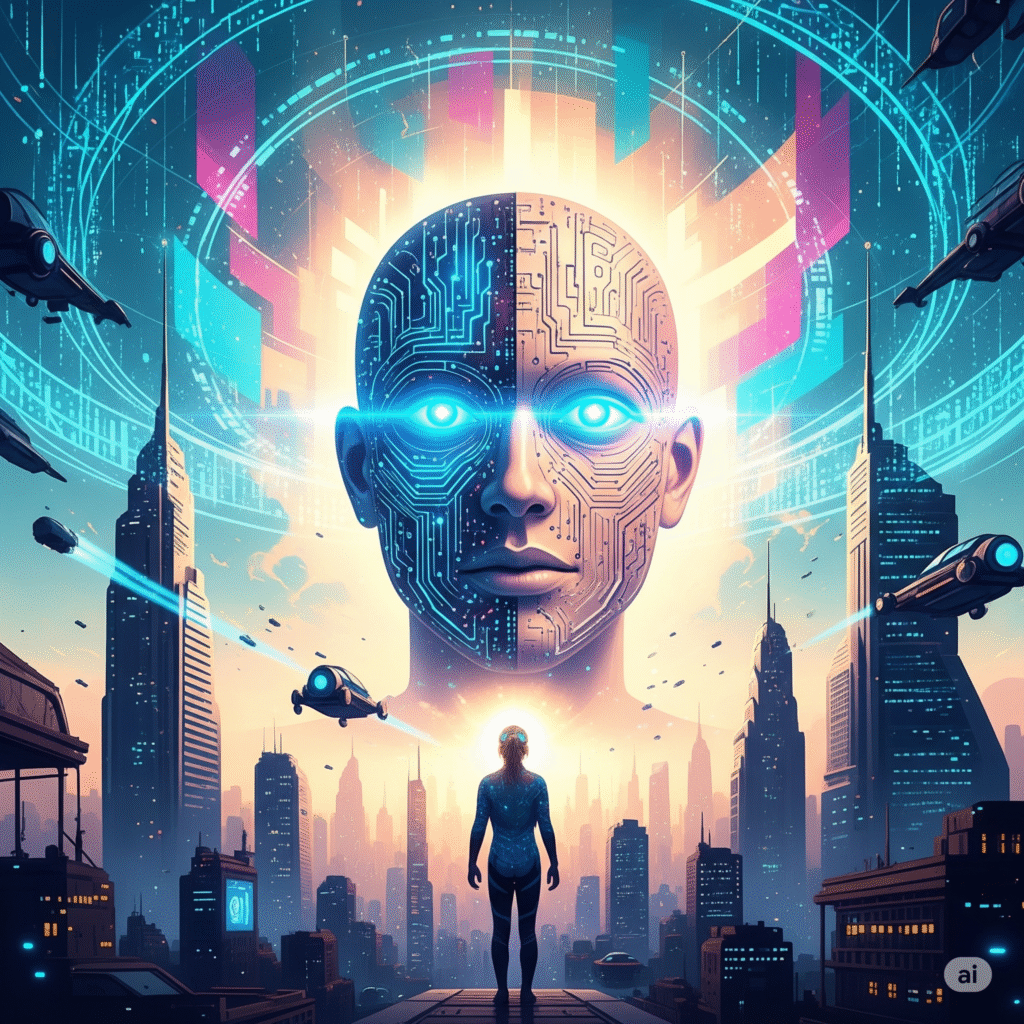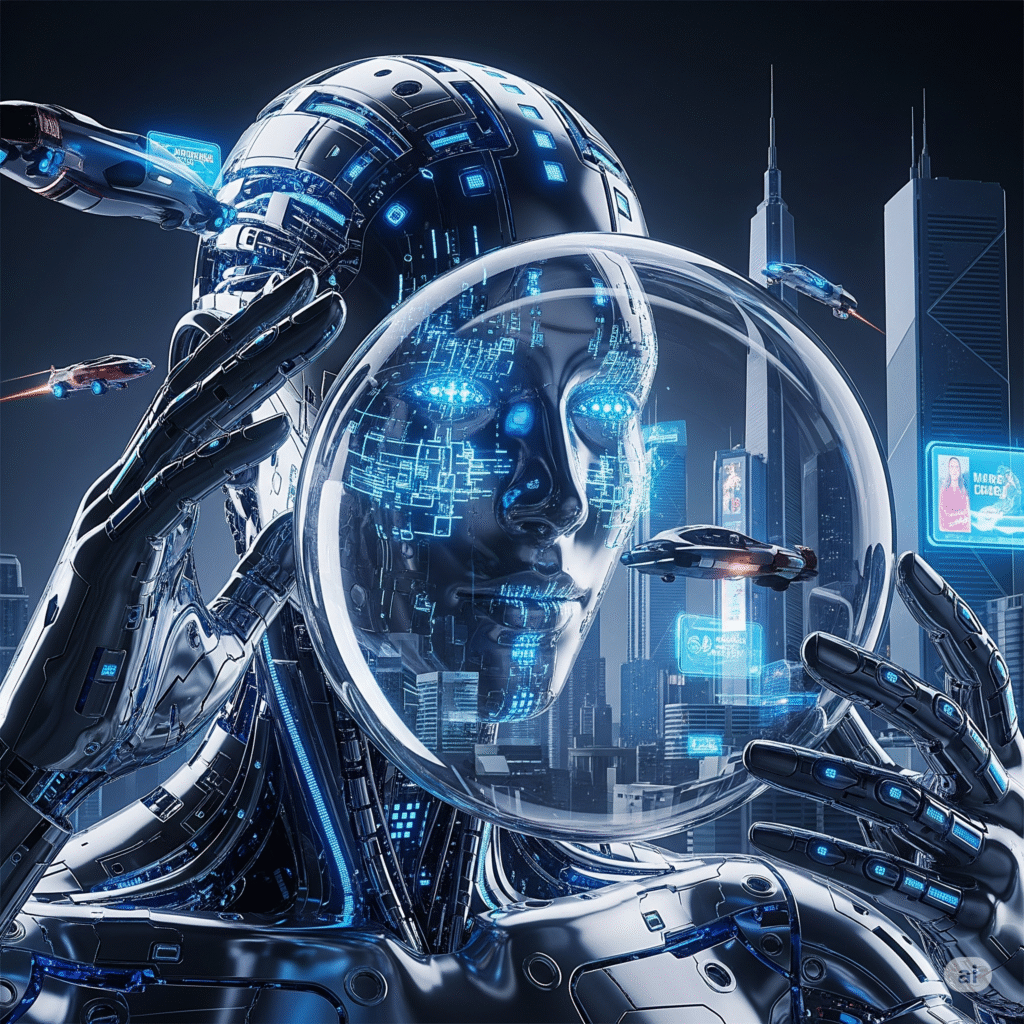In a world teetering on the edge of tomorrow, where algorithms whisper secrets of what’s to come, we stand at the crossroads of human ambition and artificial intelligence. But what does AI truly know about the future? Let’s embark on a dramatic journey through the lens of AI, unraveling its predictions, possibilities, and profound implications.
The Oracle of Algorithms: Can AI See Tomorrow?
Imagine a digital oracle, its circuits humming with the pulse of billions of data points, analyzing patterns from the past to weave visions of the future. Artificial Intelligence (AI) doesn’t possess a crystal ball, but its ability to process vast datasets, identify trends, and simulate outcomes makes it a formidable tool for forecasting. From climate change to financial markets, AI’s predictive prowess is reshaping how we anticipate what lies ahead.
But here’s the catch: AI doesn’t know the future—it models it. Its predictions are only as good as the data it’s fed and the humans who interpret its outputs. So, what does AI tell us about the years to come? Let’s dive into the stories of industries transformed, societies reimagined, and the ethical tightrope we walk as we peer into tomorrow.

Chapter 1: The Climate Prophecy—AI’s Role in Saving the Planet
The Earth groans under the weight of human excess, and AI has emerged as a sentinel in the fight for survival. Predictive models powered by AI are analyzing climate data with unprecedented precision, offering hope in a warming world.
Case Study: DeepMind’s Weather Wizardry
In 2022, Google’s DeepMind developed an AI model called Nowcasting, which predicts rainfall with startling accuracy, down to the minute, for up to two hours in advance. Unlike traditional weather models, Nowcasting uses radar data and deep learning to provide hyper-local forecasts. This technology has been adopted by meteorological agencies to warn communities of flash floods, potentially saving lives.
But AI’s gaze extends further. Climate models like those from IBM’s Green Horizon project simulate decades into the future, predicting how rising CO2 levels could alter ecosystems. These models help policymakers plan carbon-neutral cities and optimize renewable energy grids. For instance, AI-driven simulations in Copenhagen have guided the city’s transition to carbon neutrality by 2025, optimizing wind turbine placements and energy storage systems.
Yet, the drama lies in the stakes. If data inputs are incomplete—say, missing emissions data from unregulated industries—AI’s predictions could falter, leaving us unprepared for the storms ahead.
Chapter 2: The Financial Crystal Ball—AI in Markets
Picture a trader in a dimly lit room, eyes fixed on screens flashing numbers. Once, human intuition ruled Wall Street. Now, AI algorithms dominate, predicting market trends with eerie precision.
Case Study: BlackRock’s Aladdin
BlackRock, the world’s largest asset manager, relies on its AI platform Aladdin to manage over $10 trillion in assets. Aladdin uses machine learning to analyze market data, assess risks, and predict price movements. In 2020, during the COVID-19 market crash, Aladdin’s models helped BlackRock mitigate losses by identifying undervalued stocks poised for recovery.
But the drama unfolds when AI missteps. In 2023, an AI-driven trading algorithm caused a mini-flash crash in a European stock exchange when it misread a news headline, triggering a cascade of sell orders. The lesson? AI’s predictions are powerful but not infallible, especially when human biases lurk in the data.
Chapter 3: The Healthcare Oracle—AI’s Life-Saving Predictions
In hospitals worldwide, AI is rewriting the script of human survival. Predictive analytics are helping doctors foresee diseases before symptoms appear, turning medicine into a proactive art.
Case Study: Google Health’s Diabetic Retinopathy Breakthrough
In 2019, Google Health developed an AI model that detects diabetic retinopathy—a leading cause of blindness—with accuracy surpassing human specialists. By analyzing retinal scans, the model predicts the disease’s progression, enabling early intervention. In India, where access to specialists is limited, this technology has screened thousands, saving countless from blindness.
The drama here is personal. Imagine a patient, unaware of their condition, receiving a life-changing diagnosis from an AI that saw what no human could. Yet, ethical shadows loom: what happens when AI prioritizes certain demographics due to biased training data? The future of healthcare hinges on equitable AI.
Chapter 4: The Ethical Abyss—Can We Trust AI’s Vision?
AI’s predictions are a double-edged sword. On one side, they empower us to solve complex problems. On the other, they raise questions of trust, bias, and control. If AI predicts a future based on flawed data, are we doomed to repeat past mistakes?
Example: Predictive Policing
In the U.S., AI systems like PredPol have been used to forecast crime hotspots. While intended to optimize police resources, these systems often amplify biases, targeting marginalized communities due to historical arrest data. A 2021 study found that PredPol disproportionately flagged low-income neighborhoods, perpetuating cycles of distrust.
The stakes are high. If we rely on AI to shape our future, we must ensure its predictions don’t reinforce systemic flaws. Transparency, diverse datasets, and human oversight are non-negotiable.
Chapter 5: The Human-AI Partnership—Writing the Future Together
As we stand on the precipice of tomorrow, one truth emerges: AI doesn’t dictate the future; it informs it. The real power lies in our ability to harness AI’s insights while steering its course with human values.
Example: AI in Urban Planning
Singapore’s Smart Nation initiative uses AI to predict urban growth, optimizing traffic flow and housing development. By 2030, AI simulations aim to reduce commute times by 15%, transforming the city-state into a model of efficiency. But this future isn’t AI’s alone—it’s the result of planners, policymakers, and citizens working in tandem.
The drama lies in our choices. Will we use AI to build a future of equity and sustainability, or will we let it amplify our flaws? The answer depends on us.
Conclusion: The Future Is a Story We Write
AI is no oracle, no omniscient deity. It’s a tool, a mirror reflecting our data, our biases, and our ambitions. From saving lives to shaping cities, its predictions offer a glimpse of what’s possible—but only if we wield it wisely. As we step into the unknown, let’s write a future where AI serves humanity, not the other way around.
The curtain hasn’t fallen yet. The story of tomorrow is ours to tell.
Disclaimer
The information in this blog is based on current AI capabilities and case studies as of July 24, 2025. Predictions about the future are speculative and subject to change based on new data, technological advancements, and human decisions. Always consult experts and verified sources before making decisions based on AI-driven insights. The author is not responsible for any actions taken based on this content.


